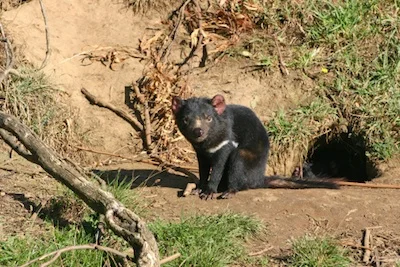Tasmanian devils live in forests in Tasmania.
They eat birds, small animals, and reptiles.
They have dark fur with some white fur.
They screech loudly.
Their strong jaws bite through bones.
The Tasmanian devil is the largest of the carnivorous (meat-eating) marsupials. They were once found all over Australia, but are now found only in Tasmania, Australia's island state.
They were probably driven south by the dingo when it came to Australia, at a time when Tasmania was joined to the mainland.
Habitat and Distribution (where they are found)
They are found in northern, eastern and central Tasmania. Their habitat is wooded countryside, in forests and near the outer suburbs of many towns.
Tasmanian devil. ©Getty Images
Appearance and Behaviours
Devils are black with a white mark on the chest and rump, and look similar to a medium sized solid dog. Their tracks are in a diamond pattern: a single paw print, followed by two paw prints side by side, and then another single print. Their front legs are longer than their back legs, which gives them a rocking movement when they run, at a top speed of about 13 kilometres per hour.
Tasmanian devils are nocturnal: they hunt at night and spend the day in a burrow. They have powerful jaws that can bite through bones. The can open their mouths in a very wide gape. When several gather at one carcass, they growl and screech loudly, but rarely injure each other. This bone-chilling screeching gave the devil its name: early settlers thought that they sounded like devils in the night.
A Tasmanian devil outside its den. ©Getty Images
Diet
Generally Tasmanian devils eat dead animals they find. This is an important activity because it means dead carcasses are cleaned up, which keeps the bush clean and on farms prevents sheep getting infected by maggots. However, they can also hunt and kill birds, reptiles and small mammals. Like many marsupials, devils can store fat in their tails to keep up nutrition when there is little food around.
Life Cycle
Mother and pup peer out of a den. ©Getty Images
After mating in March, a female gives birth 21 days later to 2-4 young, called pups, After they are born, the tiny pups make their way to their mother's pouch. Inside the pouch, there are four teats to feed milk to the young devils.
The pouch opens towards the female's back legs. They stay in the pouch for about 16 weeks, and when they are too big to fit, the female moves them to a nest. They stay there for about 16 weeks, generally starting to follow her around at the end of that time. By the age of about 40 weeks, the young are on their own, and their mother leaves them in a den.
©Getty Images
Conservation Status and Threats
Tasmanian devils are classified as Endangered, and are completely protected.
An epidemic called Devil Facial Tumour Disease is now having a terrible effect on the Tasmanian devil population. It started in the north-east of Tasmania in the mid-1990s but has now spread to other areas of the state.
Because of their habit of biting each other, particularly when sharing a carcass, devils spread the disease to each other.
©Getty Images
Scientists and vets are working to find out how the disease can be stopped. Meanwhile, groups of healthy Tasmanian devils have been moved to zoos in the mainland to breed in captivity. When Tasmania is once again disease free, those devils will be released into the wild.
It is always a good idea to use more than one source of information, so here are some others for you to investigate
Read and watch video of Tasmanian devils:
Read more about them:
tasmanian-devil-facts-for-kids







